3. Operation¶

Operation toolbar¶
The Operation toolbar is composed by 3 ‘parts’: Operation Panel, Operations and Operation actions. However, in the figure above there is no Operation actions part because there was no Veronte Autopilot 1x connected.
In the figure below, users can see these 3 ‘parts’ when an Autopilot 1x is connected:
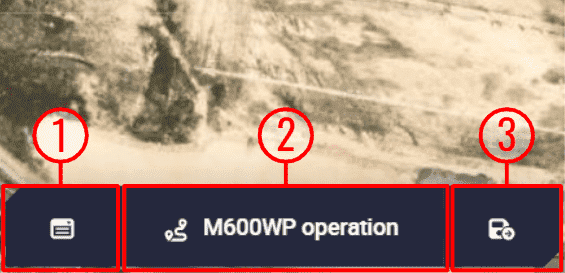
Operation toolbar - Autopilot connected¶
Operation Panel: Here the user can customize operation elements related to the operation and carry out some simple calibrations such as calibration of atmosphere, wind, DEM, etc.
Operations: Users shall be able to select an operation other than the one loaded on the autopilot and load it.
Operation actions: These are actions related to when changes are applied to the operation/mission, such as Revert, Save and Upload changes. This ‘part’ is only available when a Veronte Autopilot 1x is connected.
In addition, when a change is made, the other 2 actions (Revert and Save) appear.
Operation Panel¶
This menu is divided into 2 different functionalities: manage operation elements in the Customize tab, and simple calibrations in the Calibrations tab.

Operation Panel¶
All parameters included in this panel are explained in detail in the following sections.
Customize¶
In this part of the menu users can find all the operation elements used during the operation and mission: Operation Variables, Custom Points, Areas (prisms, cylinders and spheres), Patches, Marks, Runways, Spots and Initial position UAV.
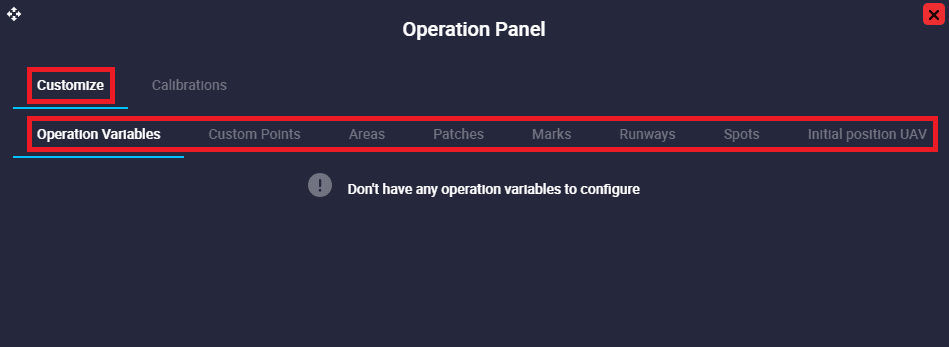
Operation Panel - Customize tab¶
If users wish to link a mark, patch, prism, etc., to one of these variables, it is first necessary to define (rename) them in the UI menu of the 1x PDI Builder software, as described and explained in the corresponding section of the 1x PDI Builder manual, click here to access it.
Operation Variables¶
Operation Variables are configurable values, postitions and directions that can vary depending on the mission.
Important
Not setting the value of an operation variable may raise errors during the operation.
Examples of Operation Variables can be:
Mission duration
Cruise speed
Flight level
Takeoff and landing direction
Home point
Start of route
Their main advantage is that it is not necessary to access Veronte Autopilot configuration to modify them. In this way, the operator can modify certain parameters without the need of having access to the entire configuration.
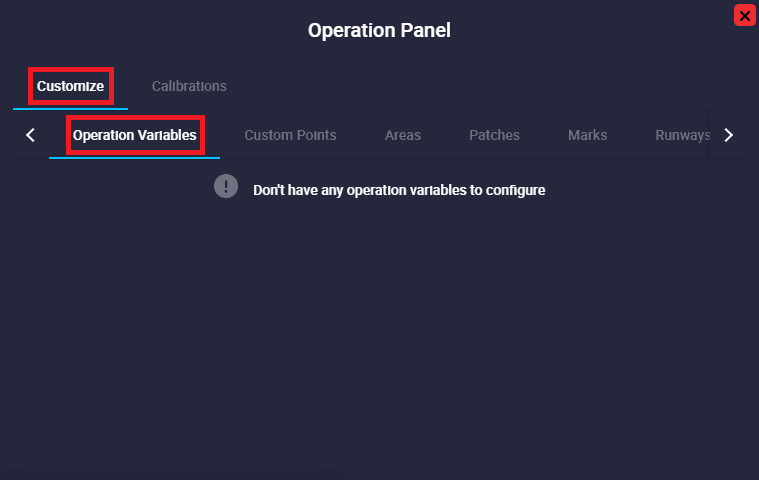
Operation Variables¶
As explained above, operation elements must be created while building a Veronte Autopilot configuration. So, when a new Operation Variable is created, a new field will appear in the operation variables tab:
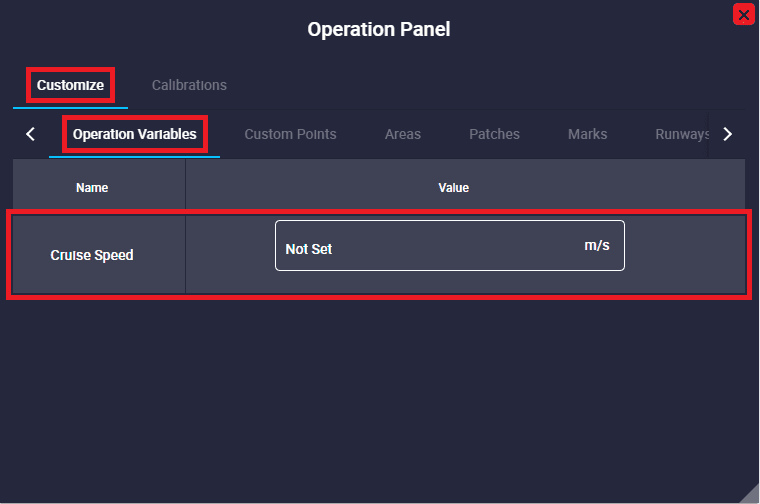
New Operation Variable¶
After this, the value of this variable can be defined using this menu. The user simply clicks on the value cell, enters the desired new value and saves the change (![]() button, this is explained in the Save operation section below).
button, this is explained in the Save operation section below).
An example is shown below:
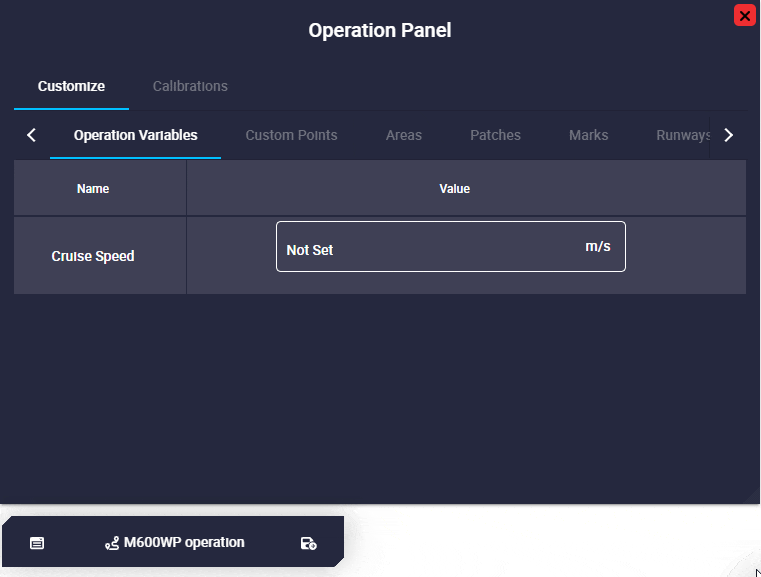
Operations Variables configuration¶
Users should note that these Operation Variables can have minimum and maximum ranges defined in their configuration in the 1x PDI Builder software.
When the Operation Variable has a range already configured:
It is mandatory to set a value in the Operation Panel, i.e. the value cell cannot be empty. Otherwise, the PDI error: 737 will be shown in the Platform panel.
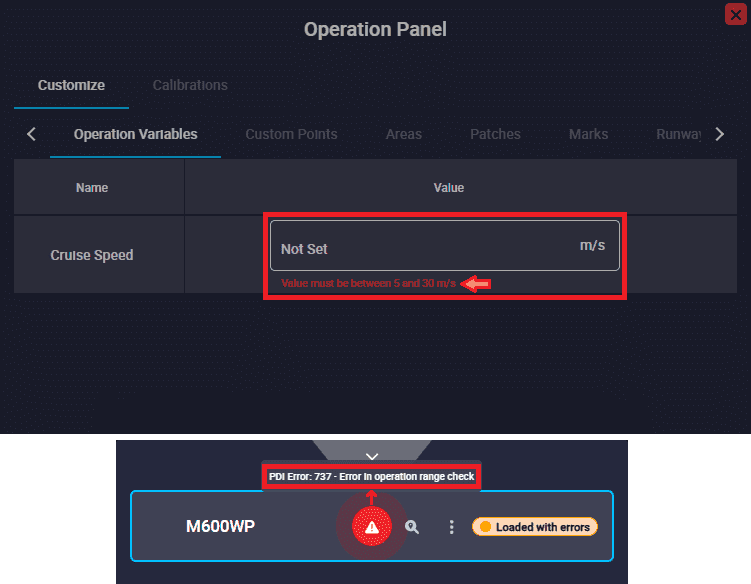
Operation Variable error: Value Not Set¶
The value that users enter here must be within the defined range, otherwise, they will not be able to save it and the software will automatically convert it to the closest value of the defined range (minimum or maximum value of the range). In addition, an error message will be displayed in the cell indicating the range.
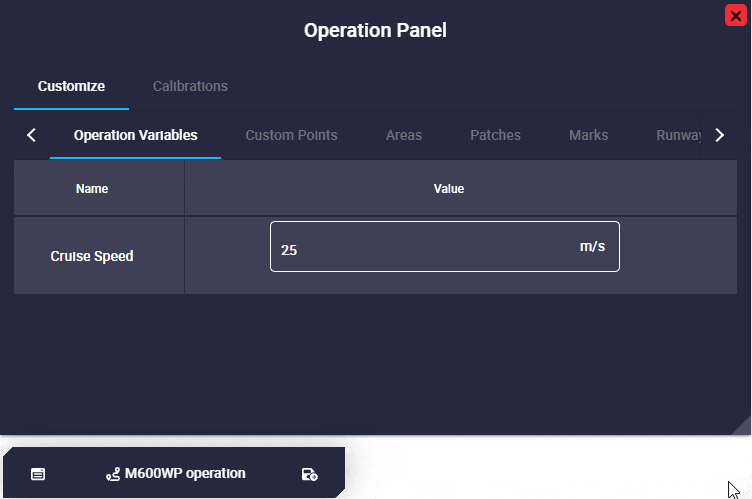
Operation Variable error: Value not in range¶
When the Operation Variable does not have a range configured in 1x PDI Builder software, setting a value is an option, not a requirement. If any value is entered, the value cell will display “Not Set”.
Furthermore, units can be changed in Veronte Ops, if they have been defined 1x PDI Builder software.
Warning
Although it is possible to modify operation elements during the flight, this practice is not recommended.
Whenever changing values during an operation, make sure that no potential risk to flight safety is involved.
Custom Points¶
A Custom point is an operation element that can be linked to a waypoint of the configured mission.
As explained above, an operation element only appears in this panel when it has been previously defined in the 1x PDI Builder software.
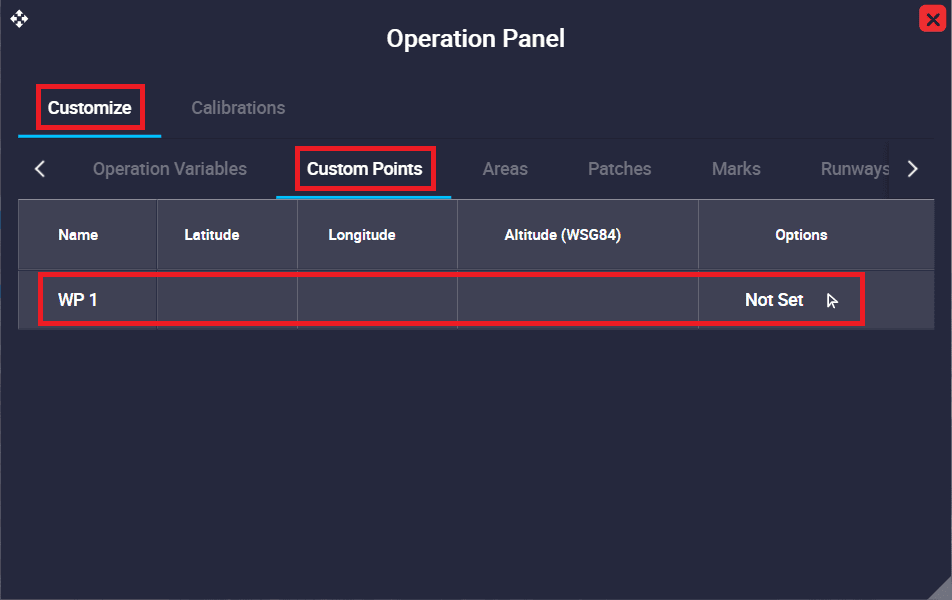
Custom point¶
Therefore, as can be seen in the figure above, this Custom point has been defined in the autopilot configuration, but is not yet configured.
To configure it, it is necessary to click on the ![]() icon to link this Custom point to a waypoint of the mission. An example is shown below:
icon to link this Custom point to a waypoint of the mission. An example is shown below:
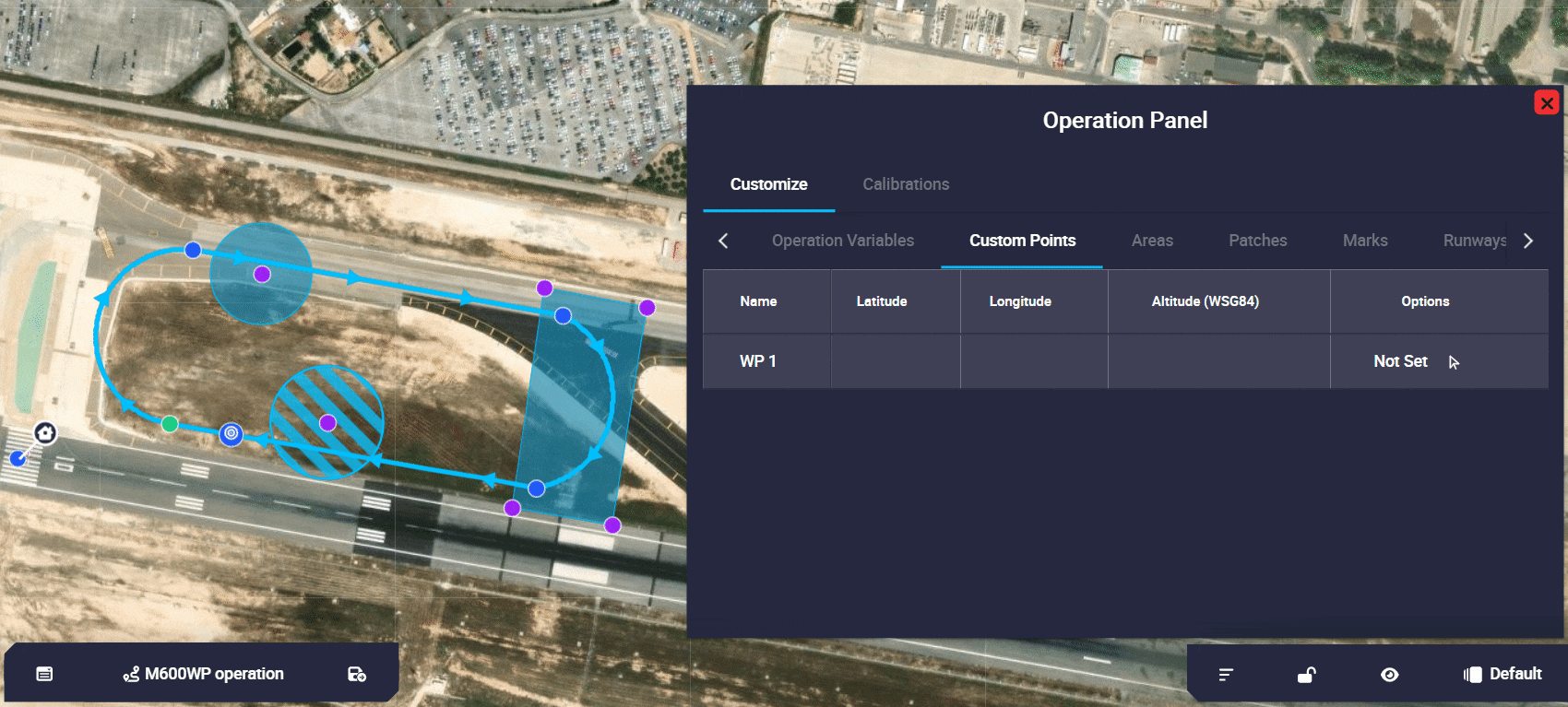
Custom point configuration - Select point¶
Once, the Custom point is linked to a waypoint, the following options will appear in the operation panel:
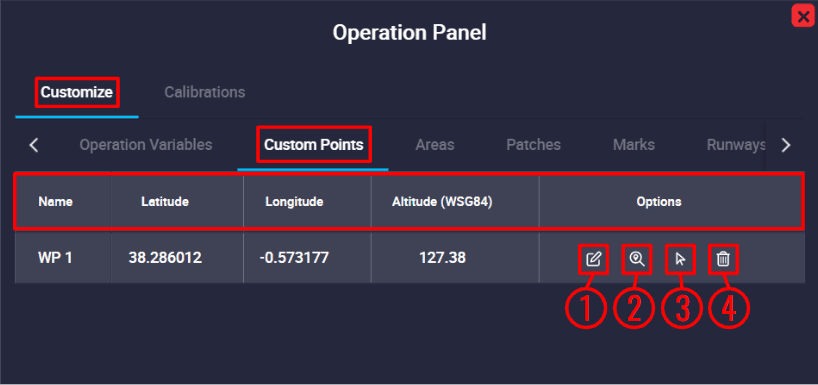
Custom point configuration¶
Name: Name of this Custom point defined in the 1x PDI Builder software.
Coordinates: Latitude, longitude and altitude (WGS884) of the selected point.
Options: These are configuration options of the Custom point:
Edit options: This option allows the user to manually edit the position of the Custom point. Its configuration is the same as for a waypoint (a detailed explanation of this has been described in the Waypoint - Mission section of this manual).
Search: By clicking here, Veronte Ops will center and zoom in on the area of the map where this Custom point is defined.
Select in map: To link the Custom point to a different waypoint, click here and select it on the map.
Remove reference: The user can remove the Custom point configuration by clicking here.
Moreover, by clicking on the linked waypoint, it will appear with the name of the configured Custom point:

Custom point description¶
Areas¶
This tab includes prisms, cylinders and spheres.
These operation elements, Prisms, Cylinders and Spheres are detection areas that can be linked to prisms, cylinders or spheres of the configured mission.
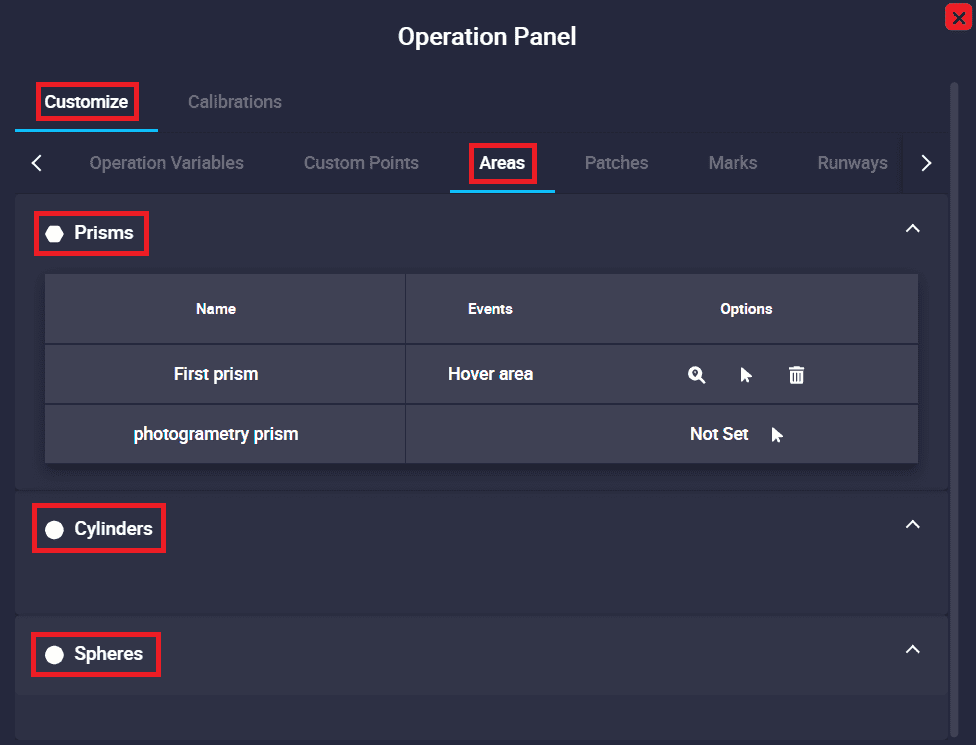
Areas¶
In the image above, the user can identify that there is a prism already defined and configured, a prism defined but not configured, and that there is no cylinder or sphere either configured or defined.
If the user wants to define cylindrical or spherical areas, this must be done in the 1x PDI Builder software, as described at the beginning of the Customize section. Then, to configure them, the process is the same as described for Custom points.
Once an Area has been defined and configured, the following options are displayed in the operation panel:
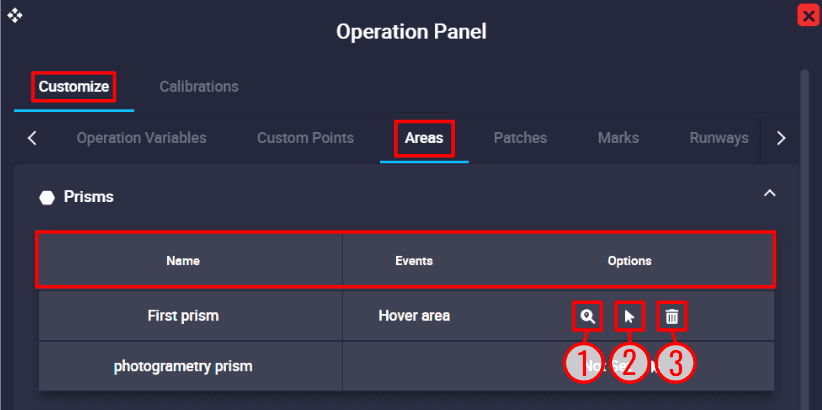
Are configuration¶
Name: Element identifier, this has been defined in the 1x PDI Builder software.
Events: Here is displayed the list of any events that are linked to this element, such as triggers for automatic actions.
Options: These are configuration options of the Area:
Search: By clicking here, Veronte Ops will center and zoom in on the area of the map where this Area is defined.
Select in map: To link this operation element to a different area, click here and select it on the map.
Remove reference: The user can remove the Area configuration by clicking here.
In addition, when clicking on the linked area, its description will appear with the name defined by the user and the events linked to it will also appear:
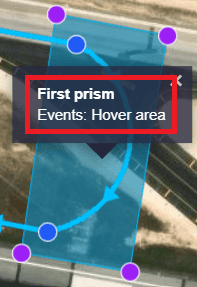
Area description¶
Patches¶
A Patch is an operation element that can be linked to patches associated with waypoints, segments, arcs or orbits of the configured mission.
This tab has the same options and works exactly the same way as the previous section (Areas section).

Patches¶
Moreover, if the event that is linked to the Patch has an associated icon and the element of the mission is the patch of a waypoint, the icon will appear at this waypoint. In addition, when clicking on it, the patch name defined by the user will appear in its description, as well as the events linked to it. An example is shown below:
Note
As this is a patch, the Operation Custom Point is not renamed as in the case of Custom Points, the name of the patch associated to this waypoint is renamed in the description.
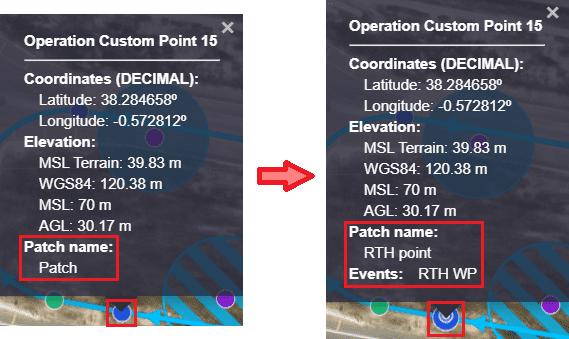
Patches - WP description¶
Marks¶
A Mark is an operation element that can be linked to a mark (reference placed in a patch) of the configured mission.
The procedure for defining and configuring a mark is the same as described above in the Areas section.
Once a Mark is configured, the following options will appear in the operation panel:
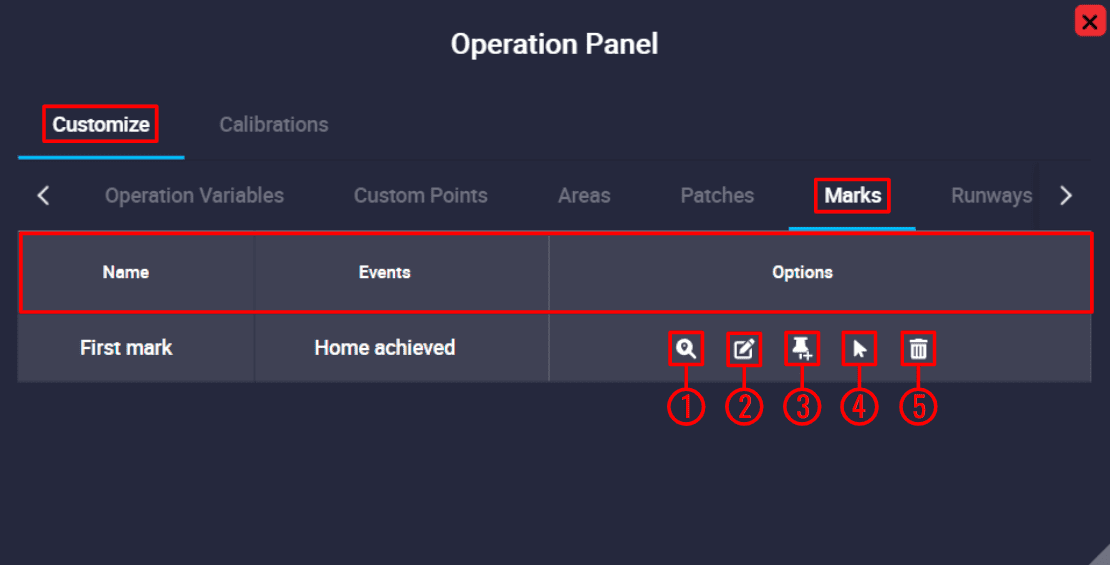
Marks¶
Name: Element identifier, this has been defined in the 1x PDI Builder software.
Events: Here is displayed the list of any events that are linked to this mark, such as triggers for automatic actions.
Options: These are configuration options of the Mark:
Search: By clicking here, Veronte Ops will center and zoom in on the area of the map where this Mark is defined.
Edit/Create:

Marks - Edit¶
Patch type: The user can select different flight guidance phases where the marks will be placed: Approach, Climbing, Route, Taxi, VTol and Rendezvous. Except for Route patches, for the rest of the guidance phase, patches are generated when the user, or an automation, activates them. As the user cannot select these patches, as they cannot be generated initially, this option will automatically create the marking on the selected patch.
Patch Selected: Most flight guidance phases have predefined patches with specific names. The user can select where the mark will be placed on those patches. A table summarising the available options is shown below.
Type: Right now the only possible option is “Referred to start” of the selected patch.
Distance: Distance from the mark to the start of the patch.
Climbing and Approach guidances are defined as follows:

Marks - Approach patches¶
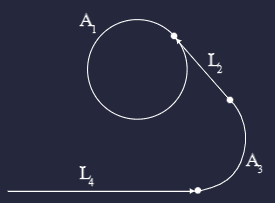
Marks - Climbing patches¶
Approach
L0/A1/L2/A3/L4/L5
Climbing
A1/L2/A3/L4
Route
512 patches
Taxi
Taxi 0/Taxi 1
VTol
VTol 0/VTol 1/VTol 3
Rendezvous
Rendezvous 0/Rendezvous 1/Rendezvous 2
Create mark in map and select: If the mark is not yet created in the mission, by clicking on this option, Veronte Ops will create it at the point on the map where the user clicks.
In addition, Veronte Ops will automatically link this operation element to this newly created marker.
Note
This option also appears although the mark is not yet configured (linked to a created mark).
Select in map: To link this operation element to a different mark, click here and select it on the map.
Remove reference: The user can remove the Mark configuration by clicking here.
Moreover, if the event that is linked to the Mark has an associated icon, the icon will appear on that mark. In addition, when clicking on it, its description will appear with the name defined by the user and the events linked to it will also appear. An example is shown below:
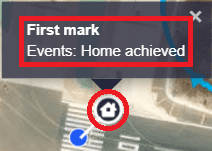
Marks - Icon and description¶
Runways¶
Runways are operation elements that can be linked to the runways of the configured mission.
Like all other operation elements, Runways have to be defined in 1x PDI Builder and then configured by selecting a runway from the map.
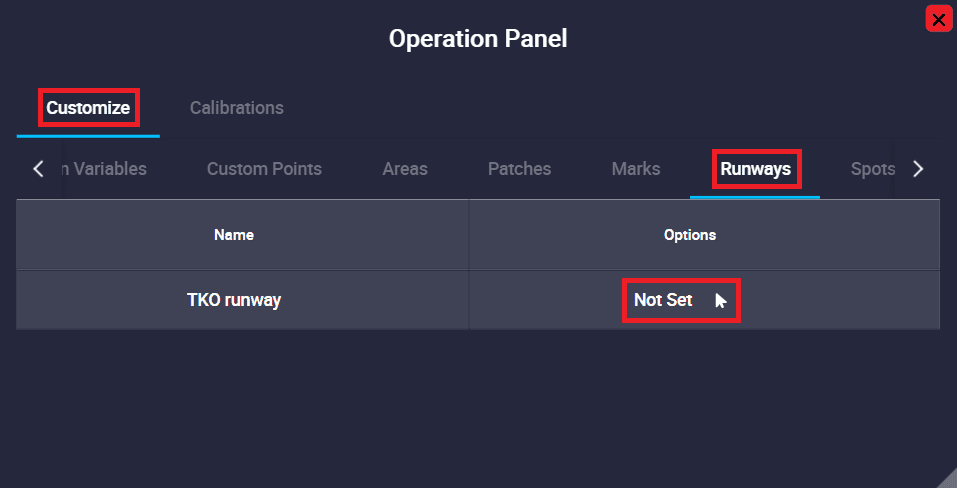
Runways¶
The following configurable options will then appear in the operation panel:
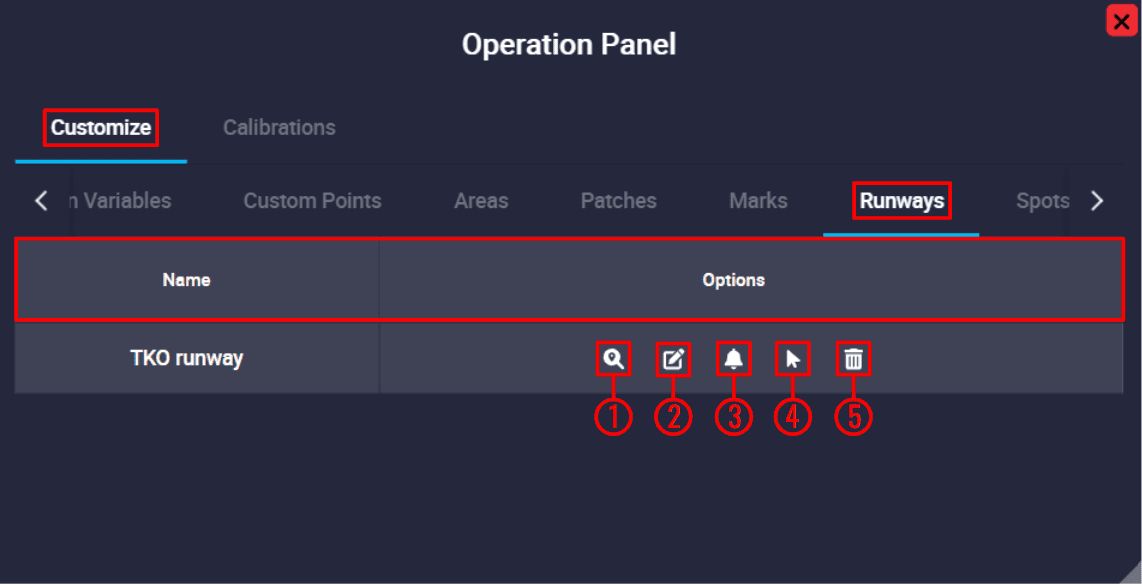
Runways configuration¶
Name: Element identifier, this has been defined in the 1x PDI Builder software.
Options: These are configuration options of the Runway:
Search: By clicking here, Veronte Ops will center and zoom in on the area of the map where this Runway is defined.
Edit: By clicking here the user will be able to modify the runway settings. A detailed explanation of how to configure it can be found in the Runway - Mission section of this manual.
Configure Alarms: Alarms can be associated to Runways. A detailed explanation of how to configure them can be found in Runway - Mission section of this manual.
Select in map: To link this operation element to a different runway, click here and select it on the map.
Remove reference: The user can remove the Runway configuration by clicking here.
Moreover, by clicking on the linked runway, it will appear with the name of the configured Runway:

Runways description¶
If the user clicks on the Start, End or Loiter points of the Runway, they are also renamed:

Runways - Start, End and Loiter points¶
Spots¶
Spots are operation elements that can be linked to the spots of the configured mission.
They function in the same way as the Runways operation elements:

Spots configuration¶
Name: Element identifier, this has been defined in the 1x PDI Builder software.
Options: These are configuration options of the Spot:
Search: By clicking here, Veronte Ops will center and zoom in on the area of the map where this Spot is defined.
Edit: By clicking here the user will be able to modify the spot settings. A detailed explanation of how to configure it can be found in Spot - Mission section of this manual.
Configure Alarms: Alarms can be associated to Spots. A detailed explanation of how to configure them can be found in Spot - Mission section of this manual.
Select in map: To link this operation element to a different spot, click here and select it on the map.
Remove reference: The user can remove the Spot configuration by clicking here.
Moreover, by clicking on the linked spot, it will appear with the name of the configured Spot:
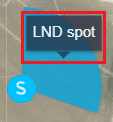
Spots description¶
If the user clicks on the spot loiter point, it is also renamed:

Spots - Loiter point¶
Initial position UAV¶
It is a marker indicating the initial position of the UAV.
In addition, users can find and center this marker on the map, as well as show/hide it.
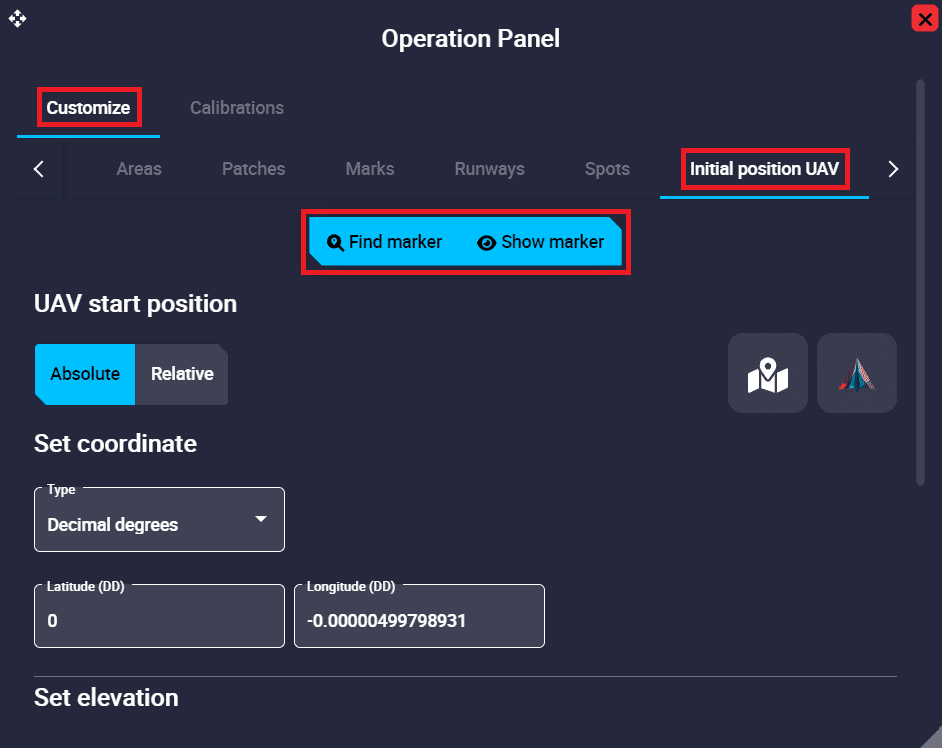
Initial position UAV¶
It is configured in the same way as waypoints. For a detailed explanatin of this, please refer to the Waypoint section of this manual.
After setting the position, it is necessary to click Accept and then Save and Upload the operation.
In the figure below, the marker is “shown” (as the hidden button appears):
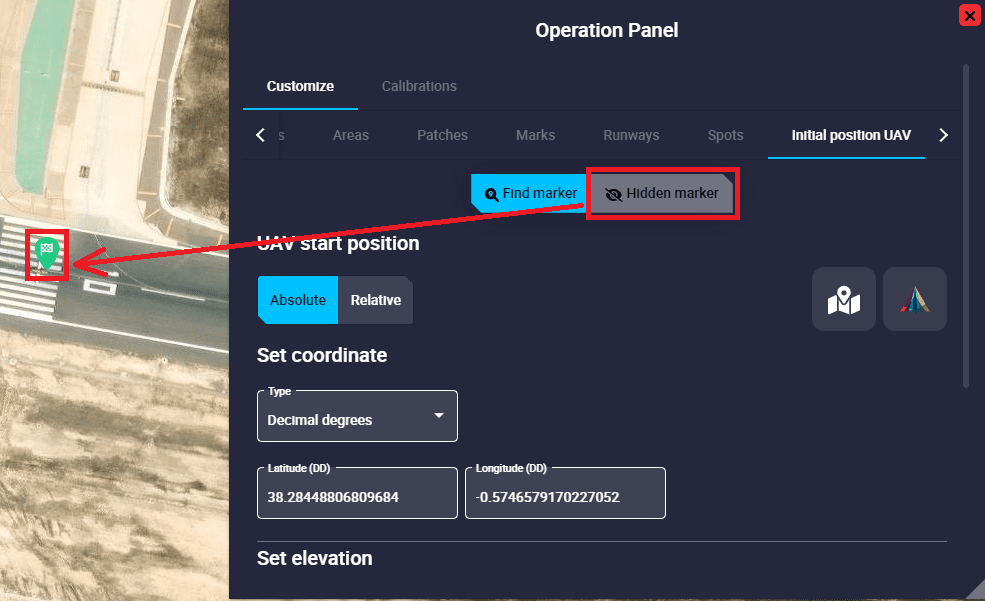
Initial position UAV - Marker in map¶
Calibrations¶
In this tab, the user can carry out simple calibrations during a standard operation. This way, there is no need of modifying the configuration or building a specific automation.
Note
Some of the following calibrations can also be triggered automatically using Automations.
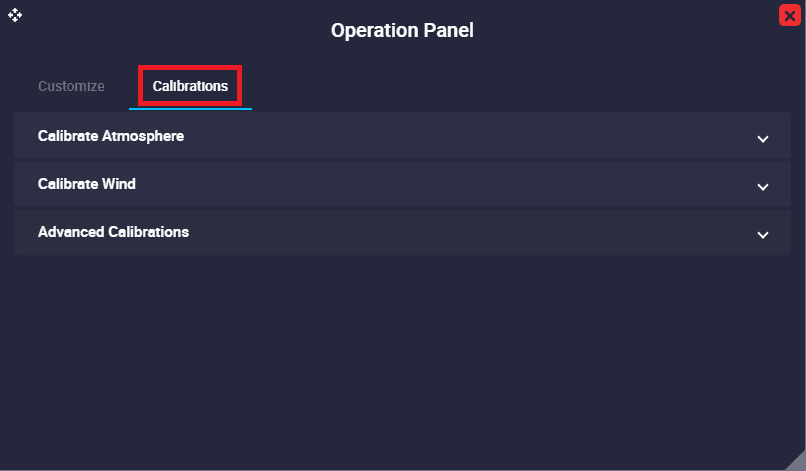
Operation Panel - Calibrations tab¶
Note
These calibrations will never modify the autopilot’s current configuration: the changes are volatile, and will disappear once the system is rebooted.
Warning
To send any of these calibrations, it is necessary to click on the ‘Send’ button.
Calibrate Atmosphere¶
Calibration for MSL calculation with barometric pressure.
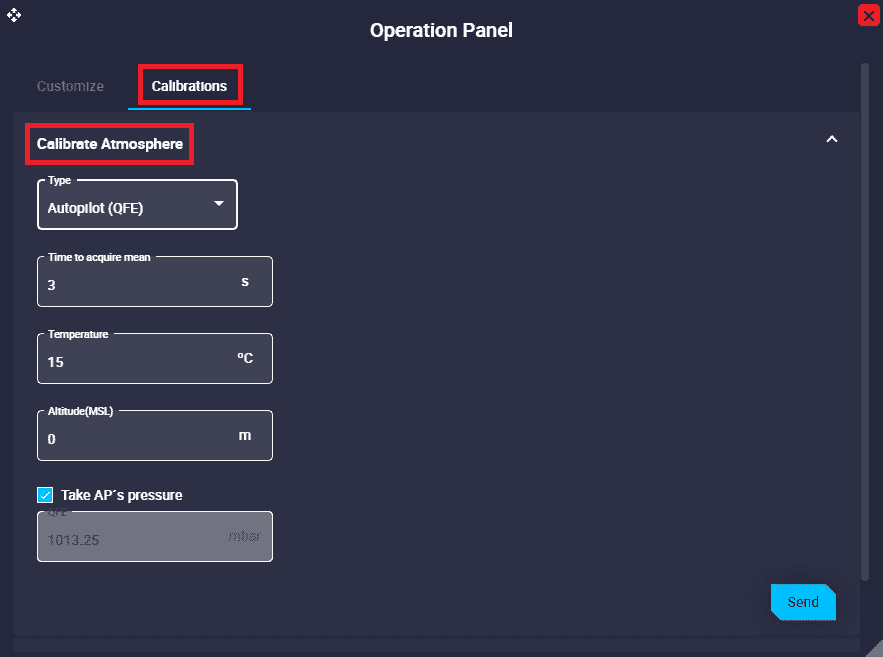
Calibrate Atmopshere¶
Type: QFE and QNH options are available.
Time to acquire mean: Specified time during which the static pressure is read from the static pressure sensor.
Temperature: Outside air temperature.
Altitude (MSL): Actual MSL altitude.
Take AP’s pressure: If enabled, static pressure will be selected from the autopilot measurement, otherwise users will have to enter it manually.
Wind Calibration¶
This command allows to enter initial values for wind state and start wind estimation algorithm.
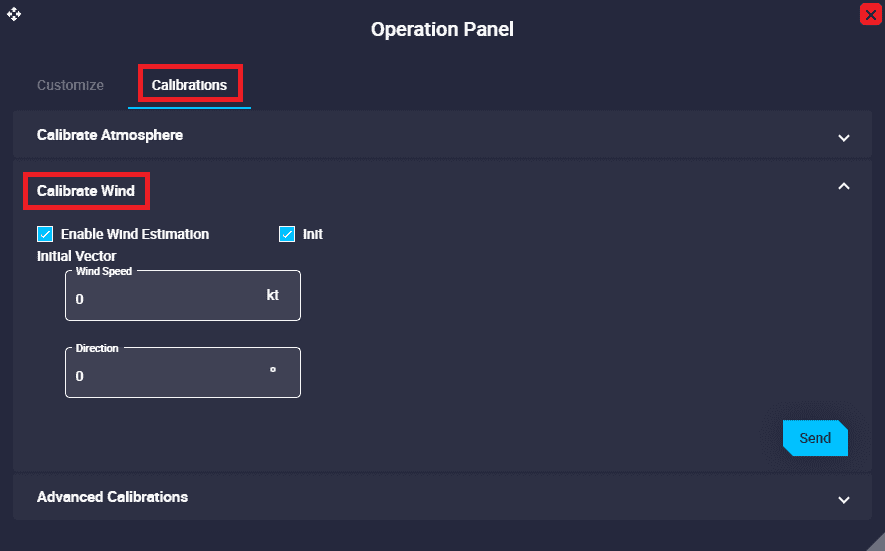
Calibrate Wind¶
Enable Wind Estimation.
Init: By enabling it, an initial wind vector can be set to a faster convergence of the estimation.
Wind Speed: Module of the initial wind speed.
Direction: Argument/Direction of the initial wind speed.
Advanced Calibrations¶
The following are the advanced calibrations that can be performed by the user during operation:
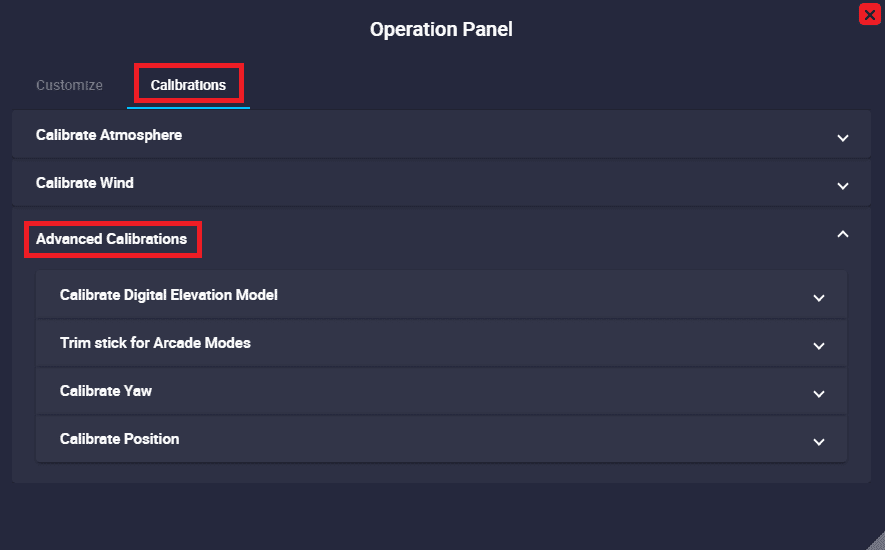
Advanced Calibrations¶
Calibrate Digital Elevation Model (DEM)
This calibration calculates the offset that the SRTM of the current point should have so that the estimated AGL results in the desired AGL (the one indicated in the calibration).
Warning
This offset is only valid for the point where the DEM has been calibrated.
Always perform this action on the ground, unless an accurate estimation of current AGL is available.
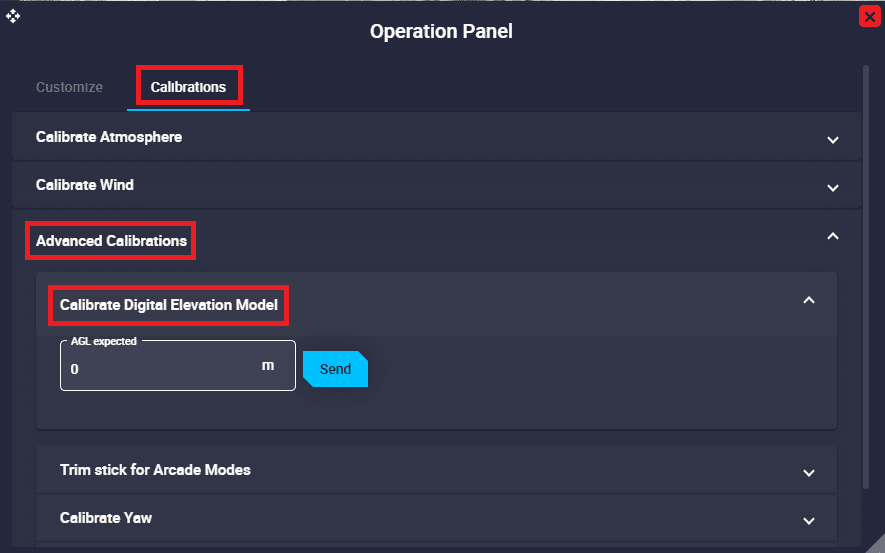
Advanced Calibrations - Calibrate DEM¶
Trim stick for Arcade Modes
This command calibrates the current stick for arcade commands.
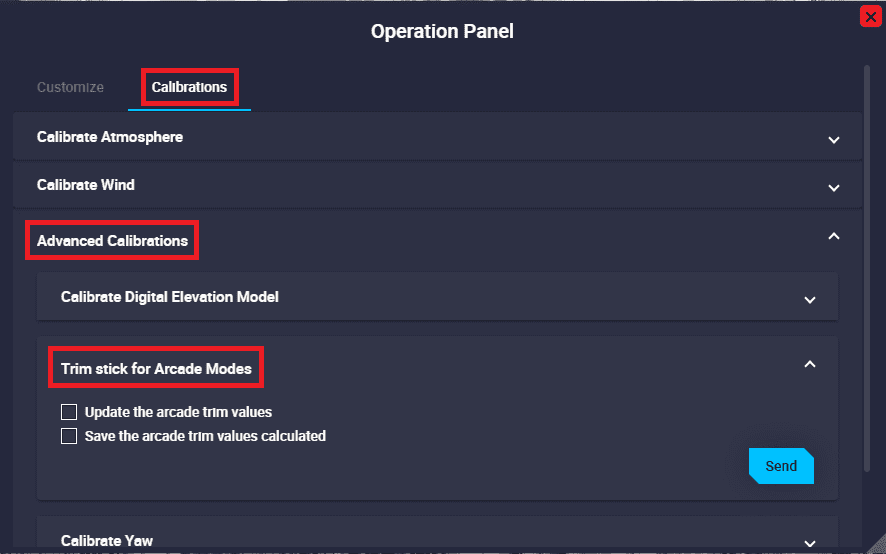
Advanced Calibrations - Trim stick¶
Calibrate Yaw
Allows to manually modify the Yaw Navigation state.
Warning
If there is any Yaw sensor active (i.e. Magnetometer), this command will not work since it will be automatically overrided.

Advanced Calibrations - Calibrate Yaw¶
Calibrate Position
Allows to manually modify the Position Navigation state.
The configurable parameters of the position calibration are the same as for configuring the position of a waypoint. So they have already been described in detail earlier in the Waypoint - Mission section of this manual.
Warning
If there is any absolute positioning sensor active (i.e. GNSS), this command will not work since it will be automatically overrided.
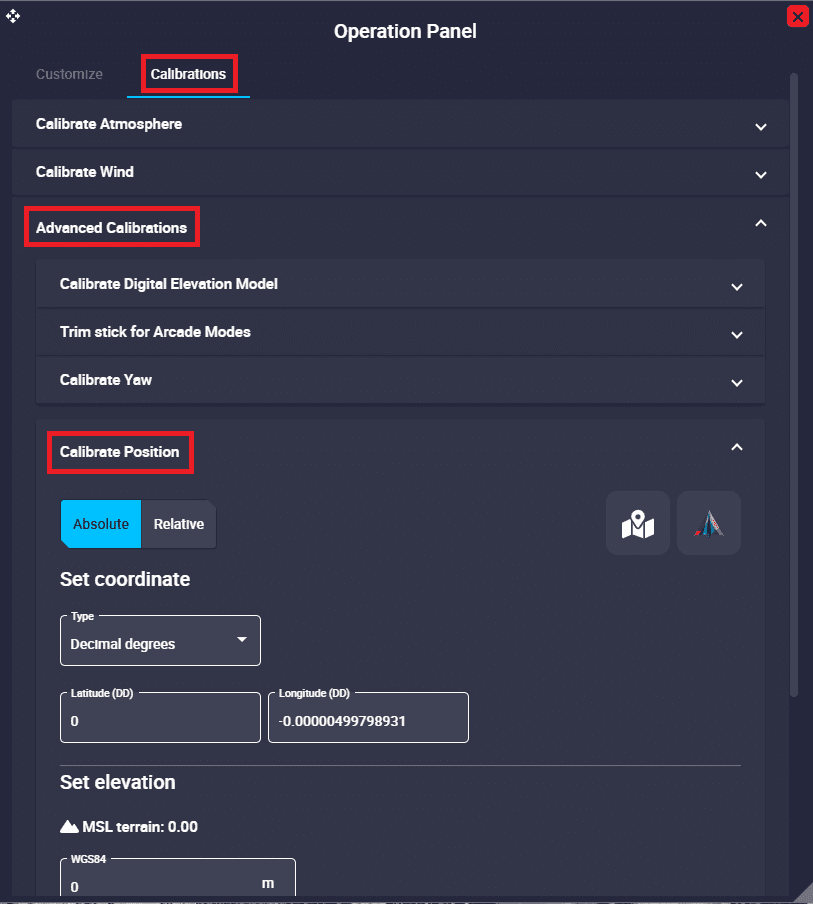
Advanced Calibrations - Calibrate Position¶
Operations¶
By clicking here, a list of all operations loaded in Veronte Ops will appear. The current operation is the one that is selected, the one shown in blue.

Operations¶
The following options are available for each operation:
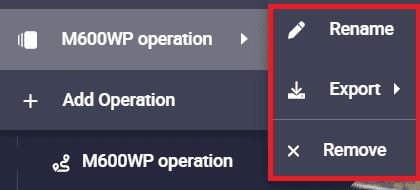
Operation options¶
Rename: The user can rename the operation as desired.
Export: The current operation can be exported, the available formats are:
ZIP,KMLandGEOJSON.Remove: Clicking here will delete the selected operation.
Note
It is possible to delete several or all operations at once from the Operation manager menu of the Status bar, click here for more infromation.
Adding an operation
It is posible to create a new operation by simply clicking on ‘Add Operation’.
The user can choose between adding an empty operation or importing one from the laptop, which has been previously exported.
The available formats for importing an operation are the same as for exporting it: ZIP, KML and GEOJSON.
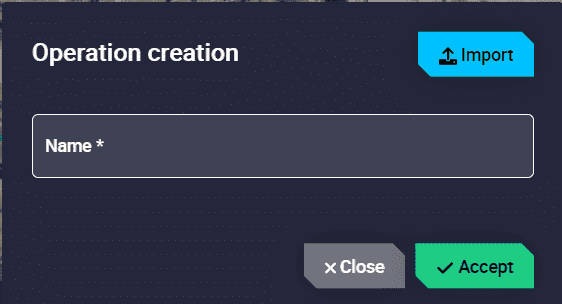
Operation creation¶
Warning
If users export an operation from Veronte Ops v6.8 and attempt to import it into Veronte Ops v6.12, Veronte Ops will not be able to import it as the operations are not compatible between versions and the following warning message will be displayed:

Importing operation error¶
Therefore, if users want to migrate an operation, they will have to upload this operation to a Veronte Autopilot 1x through the 1x PDI Builder software in version 6.12 and the migration from 6.8 to 6.12 will be performed automatically.
Note
When a configuration is saved in the 1x PDI Builder software, the following message will appear to inform the user that there is a new operation loaded in the Autopilot 1x:

Operation overwrite/new¶
If the user does not select anything, after 10 seconds this message will disappear and a new operation will be created.
If the user selects NO, a new operation will also be created, as described in the message.
If the user selects YES, no new operation will be created and the changes saved in the 1x PDI Builder software will be applied to the current operation, i.e. the current operation will be overwritten.
Operation actions¶
When a change is made, it is possible to revert it by pressing this button. This is only possible if the changes have not yet been saved.
To apply any change it is necessary to save it by pressing this button.
To update the operation loaded on the autopilot with the new saved changes, click on this button.
If there is no change to upload to the operation configuration, the following message will appear:

Nothing to Save in ‘…’¶
